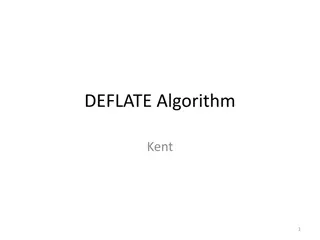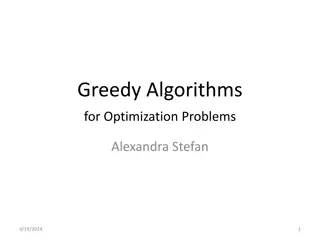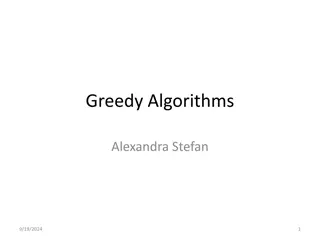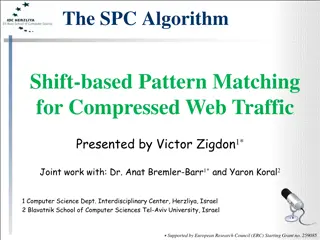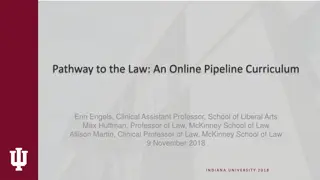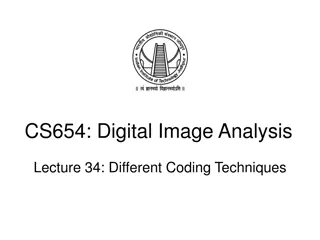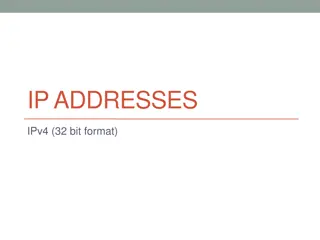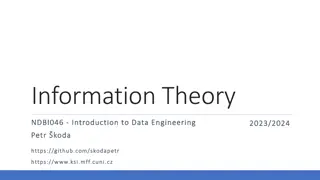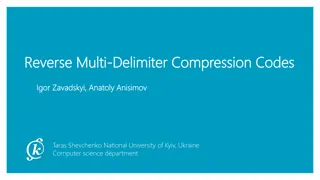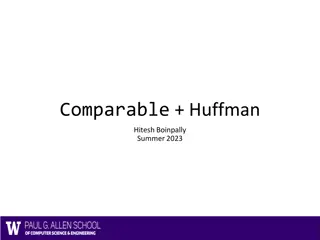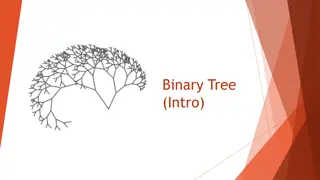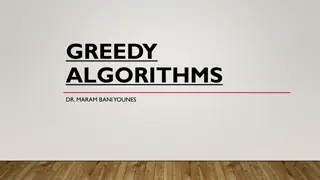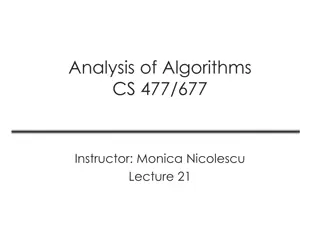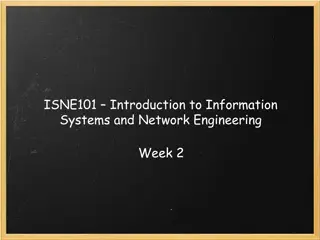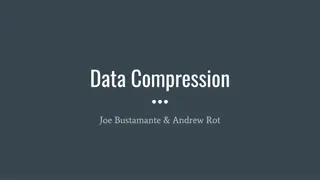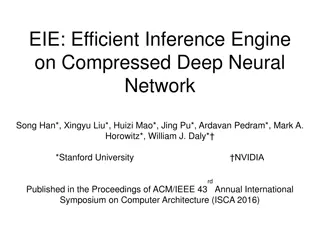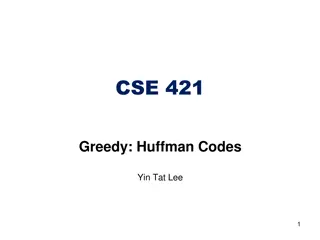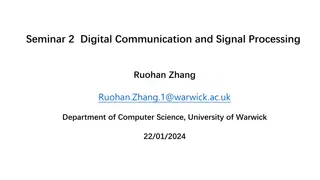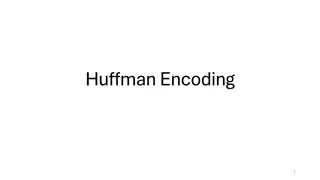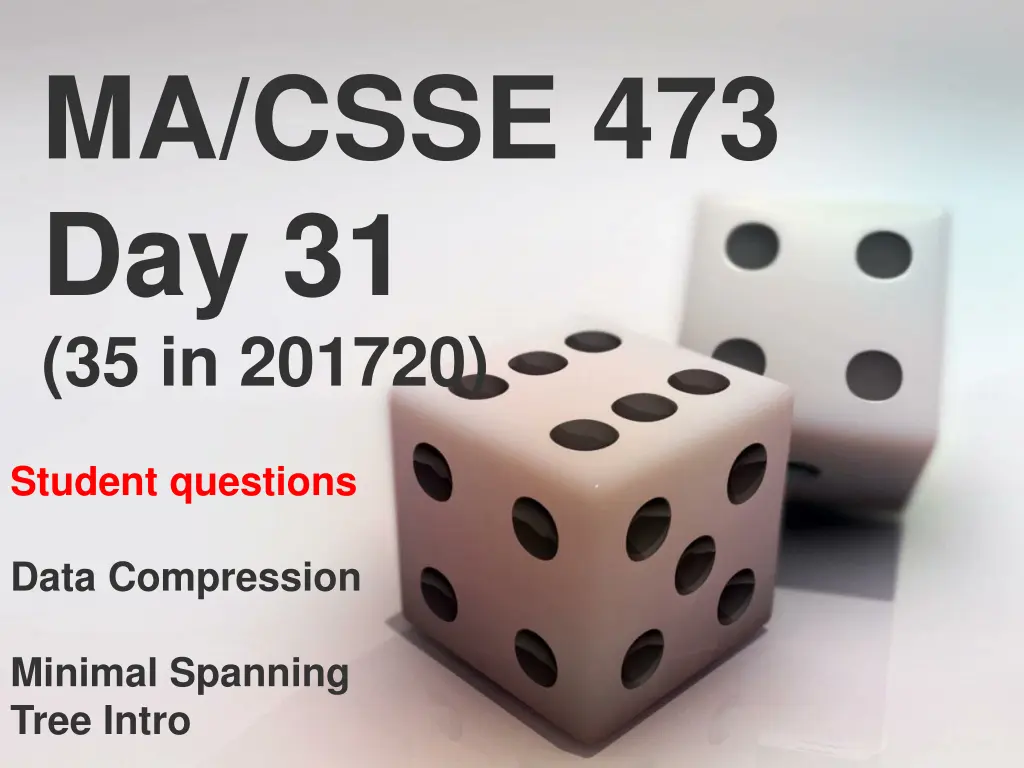
Data Compression and Huffman Encoding Techniques for Efficient Text Processing
Explore the power of data compression through Huffman encoding to optimize text representation. Understand the principles, algorithms, and advantages of variable-length codes, along with practical examples and applications.
Download Presentation

Please find below an Image/Link to download the presentation.
The content on the website is provided AS IS for your information and personal use only. It may not be sold, licensed, or shared on other websites without obtaining consent from the author. If you encounter any issues during the download, it is possible that the publisher has removed the file from their server.
You are allowed to download the files provided on this website for personal or commercial use, subject to the condition that they are used lawfully. All files are the property of their respective owners.
The content on the website is provided AS IS for your information and personal use only. It may not be sold, licensed, or shared on other websites without obtaining consent from the author.
E N D
Presentation Transcript
MA/CSSE 473 Day 31 (35 in 201720) Student questions Data Compression Minimal Spanning Tree Intro
Choose the locally best next thing GREEDY ALGORITHMS
More important than ever DATA COMPRESSION
Data (Text) Compression YOU SAY GOODBYE. I SAY HELLO. HELLO, HELLO. I DON'T KNOW WHY YOU SAY GOODBYE, I SAY HELLO. Letter frequencies SPACE O Y L E H PERIOD 17 12 9 8 6 5 4 A S I D COMMA 2 B G 4 4 3 3 U W N K T APOSTROPHE 1 2 2 2 1 1 2 2 There are 90 characters altogether. How many total bits in the ASCII representation of this string? We can get by with fewer bits per character (custom code) How many bits per character? How many for entire message? Do we need to include anything else in the message? How to represent the table? 1. count 2. ASCII code for each character How to do better?
Compression algorithm: Huffman encoding Named for David Huffman http://en.wikipedia.org/wiki/David_A._Huffman Invented while he was a graduate student at MIT. Huffman never tried to patent an invention from his work. Instead, he concentrated his efforts on education. In Huffman's own words, "My products are my students." Principles of variable-length character codes: Less-frequent characters have longer codes No code can be a prefix of another code We build a tree (based on character frequencies) that can be used to encode and decode messages
Variable-length Codes for Characters Assume that we have some routines for packing sequences of bits into bytes and writing them to a file, and for unpacking bytes into bits when reading the file Weiss has a very clever approach: BitOutputStream and BitInputStream methods writeBit and readBit allow us to logically read or write a bit at a time
A Huffman code: HelloGoodbye message Decode a "message" Draw part of the Tree
Build the tree for a smaller message I 1 R 1 N 2 O 3 A 3 T 5 E 8 Start with a separate tree for each character (in a priority queue) Repeatedly merge the two lowest (total) frequency trees and insert new tree back into priority queue Use the Huffman tree to encode NATION. Huffman codes are provably optimal among all single-character codes
What About the Code Table? When we send a message, the code table can basically be just the list of characters and frequencies Why? Three or four bytes per character The character itself. The frequency count. End of table signaled by 0 for char and count. Tree can be reconstructed from this table. The rest of the file is the compressed message.
Huffman Java Code Overview This code provides human-readable output to help us understand the Huffman algorithm. We will deal with Huffman at the abstract level; "real" code to do actual file compression is found in Weiss chapter 12. I am confident that you can figure out the other details if you need them. Based on code written by Duane Bailey, in his book JavaStructures. A great thing about this example is the use of various data structures (Binary Tree, Hash Table, Priority Queue). I do not want to get caught up in lots of code details in class, so I will give a quick overview; you should read details of the code on your own.
Some Classes used by Huffman Leaf: Represents a leaf node in a Huffman tree. Contains the character and a count of how many times it occurs in the text. HuffmanTree: Each node contains the total weight of all characters in the tree, and either a leaf node or a binary node with two subtrees that are Huffman trees. The contents field of a non-leaf node is never used; we only need the total weight. compareTo returns its result based on comparing the total weights of the trees.
Classes used by Huffman, part 2 Huffman: Contains mainThe algorithm: Count character frequencies and build a list of Leaf nodes containing the characters and their frequencies Use these nodes to build a sorted list (treated like a priority queue) of single-character Huffman trees do Take two smallest (in terms of total weight) trees from the sorted list Combine these nodes into a new tree whose total weight is the sum of the weights of the new tree Put this new tree into the sorted list while there is more than one tree left The one remaining tree will be an optimal tree for the entire message
Leaf node class for Huffman Tree The code on this slide (and the next four slides) produces the output shown on the A Huffman code: HelloGoodbye message slide.
Summary The Huffman code is provably optimal among all single-character codes for a given message. Going farther: Look for frequently occurring sequences of characters and make codes for them as well. Compression for specialized data (such as sound, pictures, video). Okay to be "lossy" as long as a person seeing/hearing the decoded version can barely see/hear the difference.
Minimal Spanning Tree (MST) for a connected network G: A tree that contains every node in G Kruskal and Prim algorithms (both are greedy) ALGORITHMS FOR FINDING A MINIMAL SPANNING TREE
Minimal Spanning Tree Definition Lt G be a network: a connected graph which has a number (weight) associated with each edge A spanning tree is a connected subgraph of G that contains all vertices of G and is a tree Among all spanning trees of G, a minimal spanning tree is one whose total weight is minimal.
Kruskals algorithm To find a MST (minimal Spanning Tree): Start with a graph T containing all n of G s vertices and none of its edges. for i = 1 to n 1: Among all of G s edges that can be added without creating a cycle, add to T an edge that has minimal weight. Details of Data Structures later
Prims algorithm Start with T as a single vertex of G (which is a MST for a single-node graph). for i = 1 to n 1: Among all edges of G that connect a vertex in T to a vertex that is not yet in T, add a minimum-weight edge (and the vertex at the other end of that edge). Details of Data Structures later
Example of Prim s algorithm
Correct? These algorithms seem simple enough, but do they really produce a MST? We examine a lemma that is the crux of both proofs. It is subtle, but once we have it, the proofs are fairly simple.
MST lemma Let G be a weighted connected graph, let T be any MST of G, let G be any nonempty subgraph of T, and let C be any connected component of G . Then: If we add to C an edge e=(v,w) that has minimum-weight among all edges that have one vertex in C and the other vertex not in C, G has an MST that contains the union of G and e. [WLOG, v is the vertex of e that is in C, and w is not in C] Summary: If G' is a subgraph of an MST, so is G' {e}


